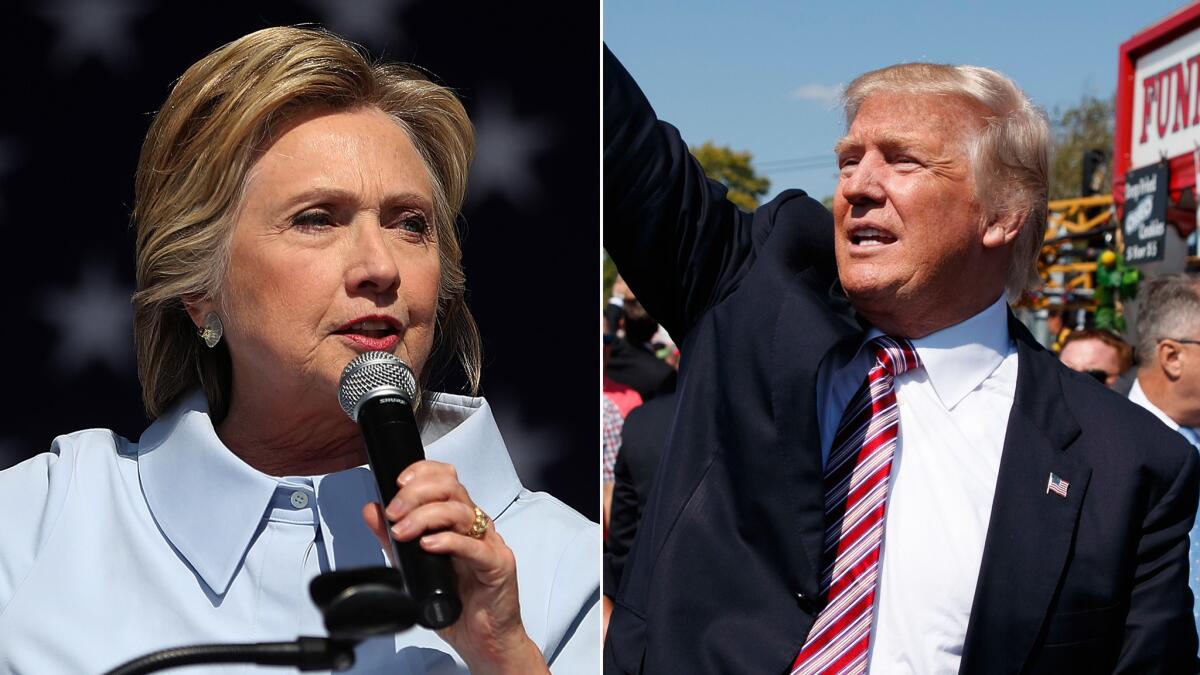Clinton has enough policy to fill a book, while Trump has said little about how he’d govern

- Share via
Reporting from Washington — There was little fanfare when Hillary Clinton released her mental health plan late last month.
The Democratic presidential hopeful didn’t visit a clinic. She didn’t surround herself with patients for a photo-op.
But for voters interested in how Clinton would tackle an issue that has frustrated policymakers for decades, she offered a 13-page, 27-point blueprint, with 25 footnotes.
“I don’t think that’s going to put her over the top in any state,” quipped Linda Rosenberg, president of the National Council for Behavioral Health, one of the nation’s leading proponents for mental health reform. “She could have probably just promised a White House conference.”
Election 2016 | Live coverage on Trail Guide | Sign up for the newsletter | The race to 270
Clinton’s mental health plan exemplifies her unusual attention to the intricacies of policy-making, which is also reflected in detailed proposals for issues as diverse as autism and climate change, infrastructure and voting rights.
More striking, the mental health blueprint highlights one of the starkest contrasts of the campaign: Rarely have two presidential nominees approached public policy more differently than Clinton and Donald Trump.
Not only has Trump offered no plan to tackle mental healthcare, he’s presented the barest of outlines for most of his governing agenda, even as he now accuses Clinton of “running a policy-free campaign,” as he claimed at recent rally in Iowa.
Trump’s vague tax, healthcare and national security proposals have baffled experts on both sides of the political aisle who have struggled to make sense of what Trump is offering.
Even Trump’s immigration policy, perhaps the signature issue of his campaign, has proved difficult to decipher.
In the same week that Clinton released her mental health plan, the Republican nominee delivered a much-anticipated immigration address, only to leave his allies working for days to clarify whether Trump would round up all immigrants in the country illegally or focus deportations on those who had broken other laws.
Such a contrast between presidential nominees’ attention to detail is highly unusual, said historian Robert Dallek.
But, he noted, it may reflect Clinton’s long history of working on public policy, as well as Trump’s thin political resume.
“Trump has this game that he will make America great again,” Dallek said, quoting Trump’s campaign slogan. “But he has no experience in government. What is he going to do?”
Trump campaign spokesman Jason Miller did not respond to multiple requests for additional information about Trump’s policy agenda and his specific plans for addressing mental illness, which affects an estimated 40 million Americans annually.
Senior officials at leading national advocacy groups including the National Alliance on Mental Illness, Mental Health America and the National Council said they had never heard from anyone at the Trump campaign.
“We’d welcome the call,” said Angela Kimball, national director of advocacy and public policy at the National Alliance on Mental Illness. “Our policy is that we will talk to anyone on these issues.”
By contrast, the Clinton campaign has been working with advocacy groups, congressional offices, health experts and others since the end of last year to develop a mental health agenda.
Campaign officials said they talked to more than 50 stakeholders over the last 10 months. And several advocacy groups surveyed by The Times said they were solicited for suggestions and asked to provide feedback on drafts, in some cases on multiple occasions.
Aides said Clinton herself had been heavily engaged in this process, directing staff to follow up on specific issues or ideas she hears on the campaign trail and marking up memos with suggestions for other subjects to explore or new experts to contact.
Altogether, roughly a dozen staffers in her Brooklyn, N.Y., headquarters focus exclusively on policy issues, according to the campaign.
The attention to policy is reflected in Clinton’s blueprint, said Mental Health America President Paul Gionfriddo.
“This is comprehensive … and moves away from that dark place focused on public safety where mental health policy was stuck for so long,” he said. “This looks at the whole picture of people’s health.”
Gionfriddo and other advocates praised the plan’s focus on early intervention to help people before their illnesses becomes debilitating, including initiatives to help pediatricians work with young children and to support school- and college-based programs.
Clinton’s plan specifically calls out five model programs already being implemented that, the plan notes, could be expanded around the country.
The campaign blueprint also includes provisions to expand community health centers to serve mentally ill patients and to boost funding for housing and employment programs to serve people suffering from mental illness.
These are crucial, said Jennifer Mathis, director of policy and legal advocacy at the Judge David L. Bazelon Center for Mental Health Law.
“Someone clearly got the message that the focus needs to be on community services, not on more hospitalizations,” she said.
The Clinton plan would dedicate additional resources to train law enforcement officials in dealing with mental illness and would strengthen enforcement of current laws designed to ensure that health insurers do not discriminate against consumers with mental illness.
Equally important, many advocates say, the plan avoids inflammatory language and references to guns and violence that many say has increased the stigma of mental illness.
“It feels like we have come a long way,” Gionfriddo said.
Trump’s campaign website mentions mental illness only briefly, calling in one section for more funding for veterans’ healthcare and noting in another section on gun rights: “Our mental health system is broken. It needs to be fixed.”
“Why does this matter to law-abiding gun owners?” that section concludes. “Because they get blamed by anti-gun politicians, gun control groups and the media for the acts of deranged madmen.”
It remains unclear whether Clinton’s more detailed approach will have much effect, especially in a year when emotion seems to be driving much of the electorate.
And history suggests policy-heavy campaigns don’t always win, said Princeton University political scientist Julian Zelizer. Democrat Hubert Humphrey lost to Republican Richard Nixon in 1968, and in 2000, Democrat Al Gore lost to George W. Bush. Both winners offered a more visceral message to voters.
Clinton nevertheless is pushing ahead with her agenda, continuing to add policy papers to a portfolio of issues that now tops three dozen on her campaign website.
Earlier this month, the campaign released “Stronger Together,” a 256-page book detailing Clinton’s governing agenda.
“We have this old-fashioned idea that if we’re asking you to support us for president, we ought to tell you what we’re going to do,” Clinton told a crowd at a recent rally in North Carolina. “Not just bluster. Not just empty words. Not just demagogic rhetoric. Real plans.”
Trump last week finally offered some detail on his pledge to expand family leave, and the campaign has made new proposals to expand school choice. Trump has promised more information about his tax plans soon.
Heading into the first debate Sept. 26, which will probably highlight contrasts between how the nominees present their agendas, other Trump policies remain largely a mystery.
When pressed earlier this month during a candidate forum for details about how he would fulfill his pledge to defeat Islamic State, Trump again deferred.
“I don’t want to broadcast to the enemy exactly what my plan is,” he said.
Twitter: @noamlevey, @mikememoli
Democratic and Republican voters are further apart than they’ve been in a generation. Here’s why
She once compared Donald Trump to a ‘street dog.’ Now it’s her job to sell him to Latino voters
UPDATES:
Sept. 20, 1:35 p.m. This post has been updated throughout.
This article was originally posted Sept. 14 at 3 a.m.
More to Read
Get the L.A. Times Politics newsletter
Deeply reported insights into legislation, politics and policy from Sacramento, Washington and beyond. In your inbox three times per week.
You may occasionally receive promotional content from the Los Angeles Times.












